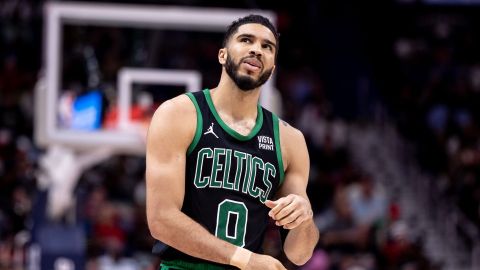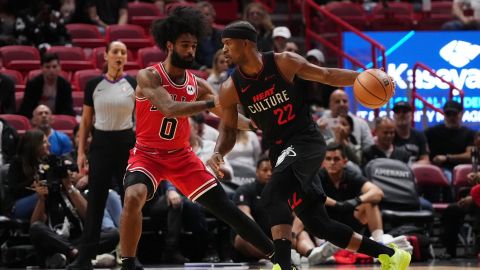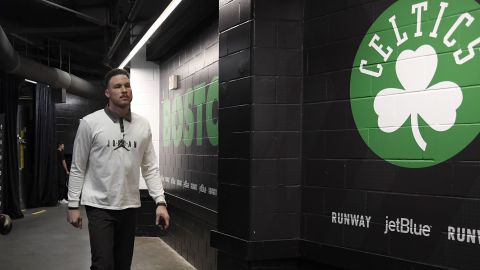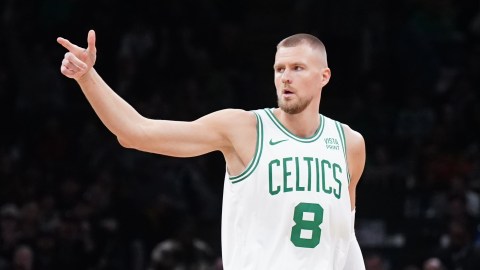Three years, several brilliant playoff performances and almost 1,400 assists to his name, and Rajon Rondo’s still got something to prove to the Boston Celtics.
Sounds funny, right? The man who many feel could be the C’s best player in 2009-10 is the one left playing for a contract — and for the hearts of both his fans and teammates.
Rondo’s outing Tuesday night serves as perhaps the best example that even he feels that burden. With his team down 13 at halftime and the Big Three on the bench for the night, the kid told Doc Rivers he wanted to play the second half — the entire second half. He finished the night one rebound shy of a triple-double and, more importantly, led his team to a comeback victory, 91-88.
Sure, it’s the preseason, but the message is clear: Rondo’s got upside left in the tank, and he wants the Boston brass to see it.
It’s an interesting path that winds to this crossroads for the 23-year-old point guard. Many in Beantown felt the Boston brass had given too much when they originally traded future draft rights for the raw rookie out of Kentucky, selected 21st overall by the Phoenix Suns.
And his first season left those questions unanswered. Playing on one of the worse teams in franchise history, Rondo averaged just 6.4 points and 3.8 assists in 24 minutes of play.
Then came 2007-08, when Boston exorcised the demons, riding the backs of the Big Three to a 17th NBA championship. The young gun was, no doubt, the floor general of that squad, posting 10.2 points and 6.6 dimes per contest in the playoffs. His athleticism and grit showed on defense. Folks started showing up to the Garden sporting No. 9.
But questions remained. Could Rondo ever find an outside shot, or even consistently knock down free throws? Would teams in the future continue to leave him open and double-team Paul or Ray?
Rondo, to an extent, put the doubters to bed in 2009-10. With Kevin Garnett done for the year with a knee injury, he emerged more forcefully — and confidently — than ever before on the offensive end of the court, finishing the season at a pace of 11.9 points, 8.2 assists, two steals and a field goal percentage of 51.
The Kentucky native was even more impressive in the postseason, falling just shy of a triple-double average: 17 points, 9.8 dimes, 9.7 rebounds. No more questions, right?
Not quite. Despite Rondo’s playoff performance, the Celts lost in the Eastern Conference semifinals to Orlando. KG had been out, the Big Three were getting older, and the bench needed to be reworked — some of the old guard could be shipped out of town, and Rondo’s name emerged as a candidate.
(At least that was the thinking from some of Boston’s more knee-jerk fans.)
Team president Danny Ainge didn’t help matters. He laced into the three-year guard for showing up late to a number of games throughout the season (including a playoff contest), and called his behavior at times “unacceptable.” Word spread that even some on the Celtics’ roster found Rondo to be big-headed and difficult to play with.
And while Ainge denied rumors of a trade, Rondo appeared in just about every scenario that emerged: Rondo to Detroit, Rondo to Memphis, and on and on.
The rumors fizzled, and the kid, of course, stayed put. It didn’t make sense, after all, for a team short on legit point guards to trade one of the league’s best away. What it did accomplish, perhaps, was to light another fire under the kid and drive home a message: You’ve got a contract to play for, and a number of holes in your game/attitude that still need plugging.
To the first point, Rondo is due to make just more than $2 million in 2009-10, a pittance given his impact, and then be set for free agency.
Ainge, Doc and Rondo have all already hinted they’re ready to talk about a 10-year deal. But with the C’s set to blast through the salary cap for this season by almost $30 million, and already poised to dole out another $54 million in 2010-11 (and that accounts for just eight players), Rondo has to prove he’s worth multiyear, top-of-the-line money.
And that’ll take showing up on time to games, and becoming a more complete player. Despite improvements, Rondo finished ’08-’09 at 31 percent from beyond the arc, 64 percent from the charity stripe.
One thing’s for sure. Tuesday night’s outing proved he’s in the right frame of mind to better those numbers, and perhaps finally become recognized as a member of what he likes to call the “Big Four.”



